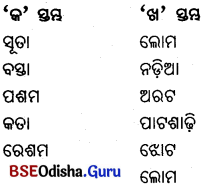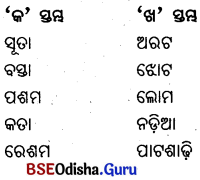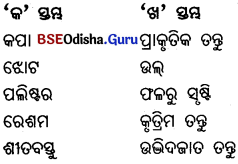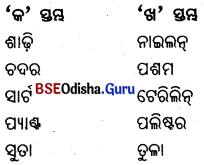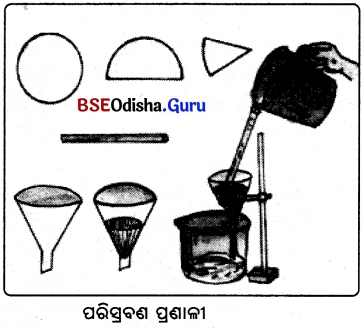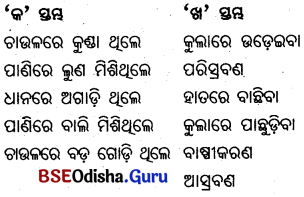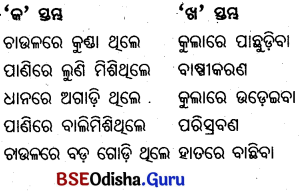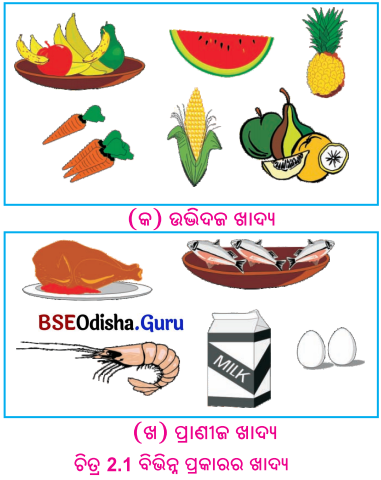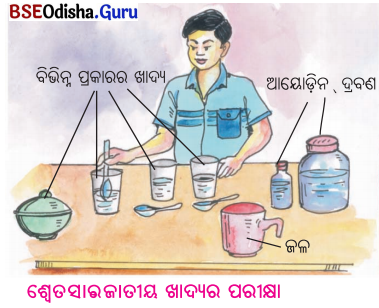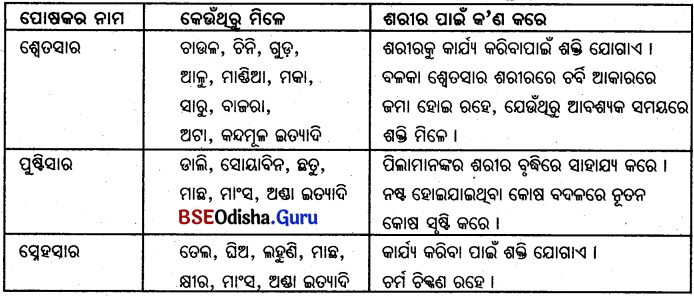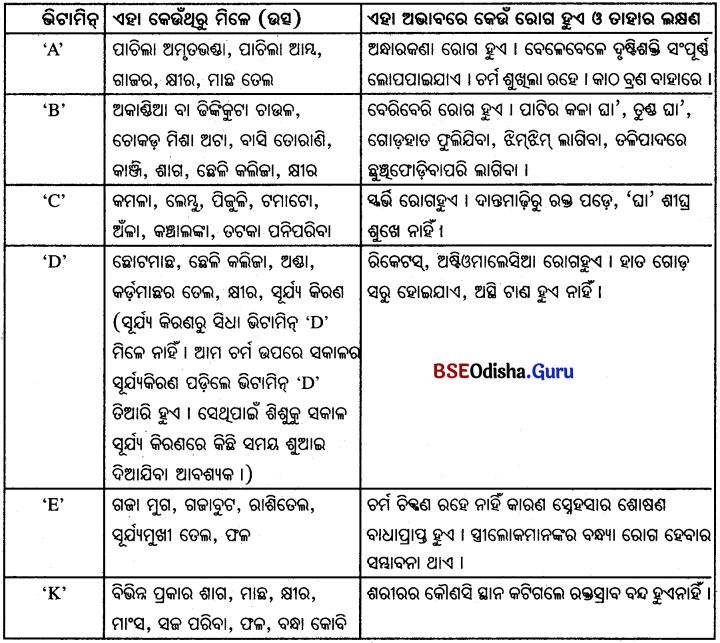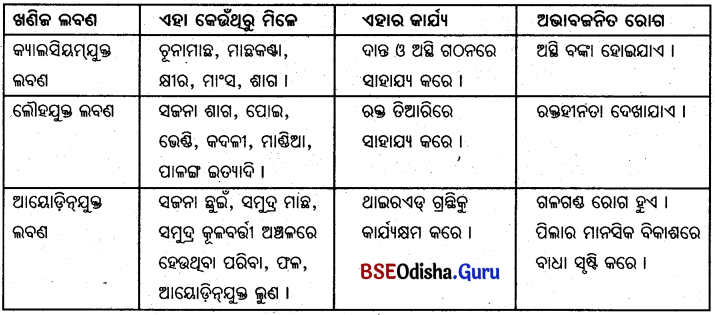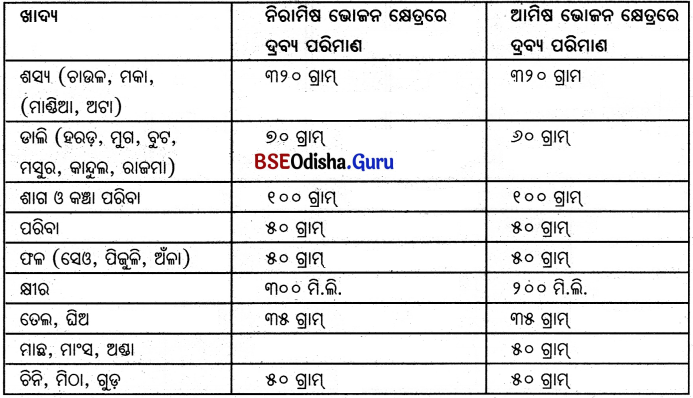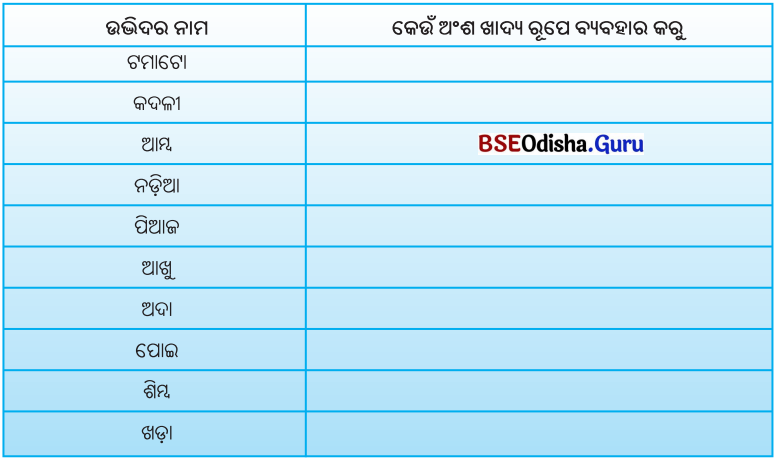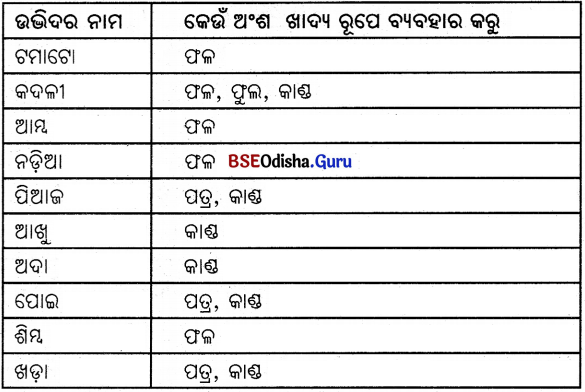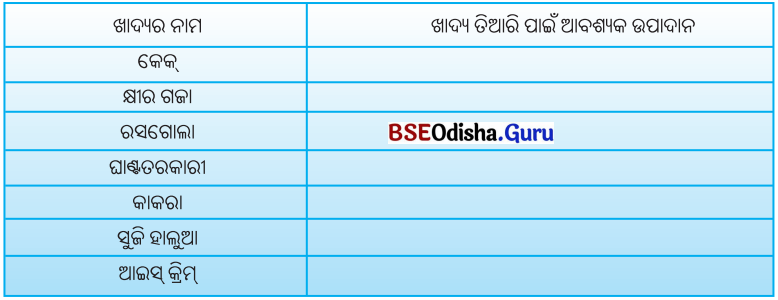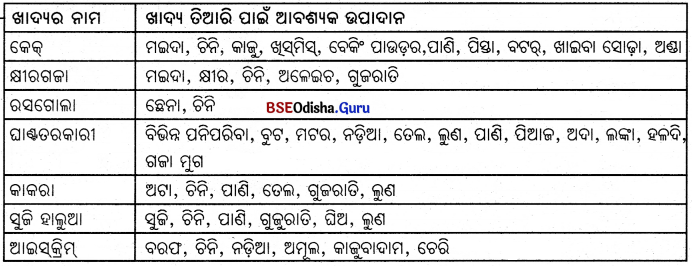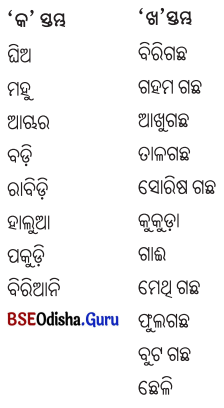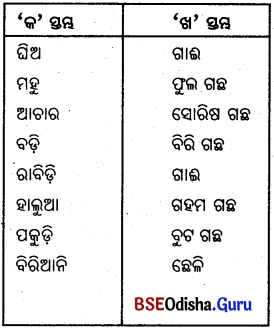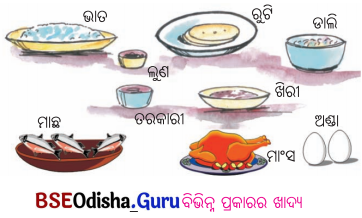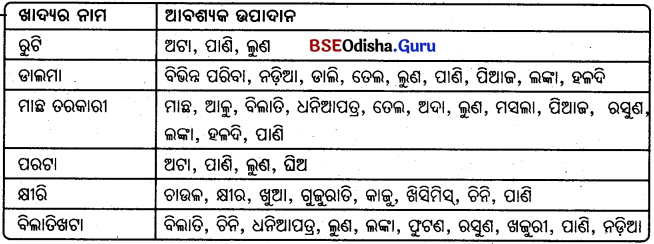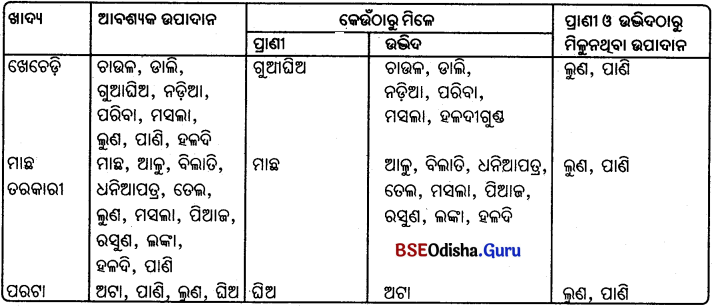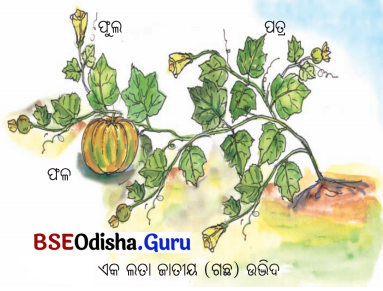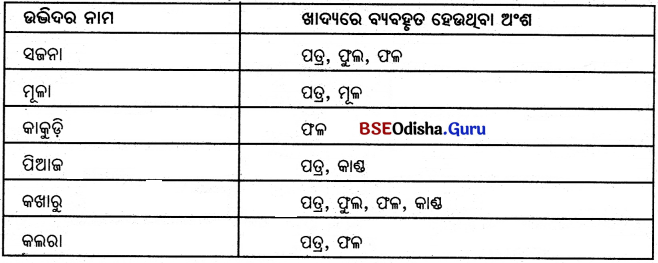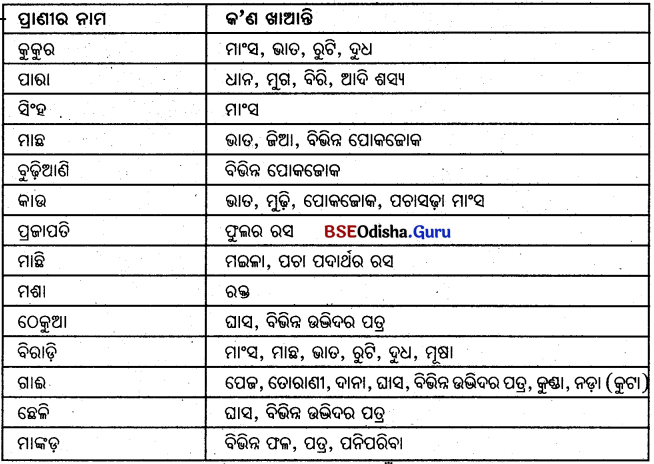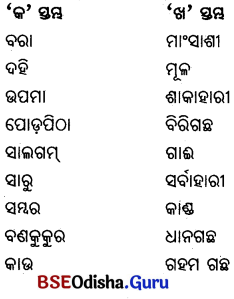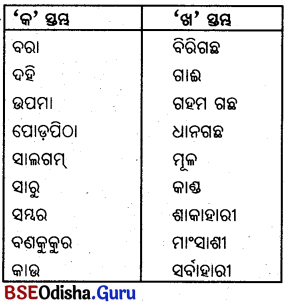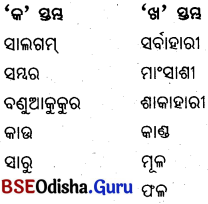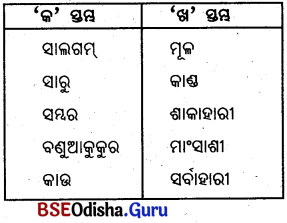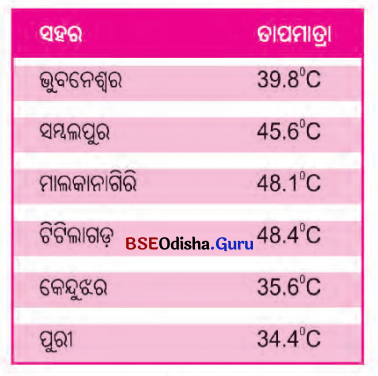Odisha State Board BSE Odisha 6th Class Maths Solutions Chapter 2 ସଂଖ୍ୟା ସମ୍ବନ୍ଧୀୟ ଅଧ୍ବକ ଆଲୋଚନା InText Questions Textbook Exercise Questions and Answers.
BSE Odisha Class 6 Maths Solutions Chapter 2 ସଂଖ୍ୟା ସମ୍ବନ୍ଧୀୟ ଅଧ୍ବକ ଆଲୋଚନା InText Questions
ଗୋଟିଏ ସାଇକେଲ ଦୋକାନରେ 15ଟି ସାଇକେଲ ଥିଲା। ତିନିଦିନରେ ଯଥାକ୍ରମେ 3, 2 ଓ 4ଟି ସାଇକେଲ ବିକ୍ରି ହେଲା। ତା’ପାଖରେ ଆଉ କେତୋଟି ସାଇକେଲ ରହିଲା?
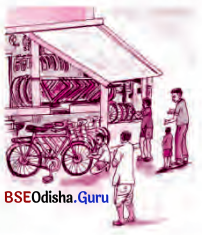
ସମାଧାନ:
ତିନି ଦିନରେ ମୋଟ ବିକ୍ରି ହୋଇଥିବା ସାଇକେଲ୍ ସଂଖ୍ୟା = 3 + 2 + 4 = 9
ତିନି ଦିନ ପରେ ବଳକା ଥିବା ସାଇକେଲ୍ ସଂଖ୍ୟା = 15 – 9 = 6
ଏହି ପ୍ରଣାଳୀରେ ତିନି ଦିନରେ ବିକ୍ରି ହୋଇଥିବା ମୋଟ ସାଇକେଲ ସଂଖ୍ୟାକୁ ପ୍ରଥମେ ଗୋଟିଏ ସଂଖ୍ୟାରେ ପ୍ରକାଶ କରାଯାଇଛି ଓ ପରେ ପୂର୍ବରୁ ଥିବା ସାଇକେଲ ସଂଖ୍ୟାରୁ ଏହାକୁ ବିୟୋଗ କରାଯାଇଛି ।
ବଳକା ଥିବା ସାଇକେଲ ସଂଖ୍ୟାକୁ ଅନ୍ୟ ରୂପରେ 15 – (3 + 2 + 4) ଭାବେ ଲେଖାଯାଇପାରିବ । ଏଠାରେ 3, 2 ଓ 4 କୁ ଏକାଠି କରିବା ପାଇଁ ‘ବନ୍ଧନୀ’’ ( ) ଚିହ୍ନର ବ୍ୟବହାର କରାଯାଇଛି ।
କହିଲ ଦେଖ୍ :
ଲିପିର ହିସାବ କାହିଁକି ଭୁଲ୍ ହେଲା ?
ସମାଧାନ:
ବନ୍ଧନୀ ବ୍ୟବହାର କରିନଥିବାରୁ ଲିପିର ହିସାବ ଭୁଲ୍ ହୋଇଥିଲା ।
ଆସ, ତଳେ ଦିଆଯାଇଥିବା ପ୍ରତ୍ୟେକ୍ତ ଉକ୍ତିକୁ ବନ୍ଧନୀ ବ୍ୟବହାର କରି ପ୍ରକାଶ କରିବା ।
(କ) 27ରୁ 2, 5 ଓ 4 ର ଯୋଗଫଳକୁ ବିୟୋଗ କରିବା;
ସମାଧାନ:
27 – (2 + 5 + 4)
(ଖ) ପନ୍ଦର ଓ ତିନିର ସମଷ୍ଟିକୁ ଛଅ ଦ୍ବାରା ଗୁଣିବା;
ସମାଧାନ:
(15 + 3) × 6
(ଗ) ଦଶରୁ ତିନି କମାଇ ମିଳିଥିବା ସଂଖ୍ୟାକୁ ଛଅଦ୍ଵାରା ଗୁଣନ କରିବା;
ସମାଧାନ:
(10 – 3) × 6
(ଘ) ଷାଠିଏକୁ ଚାରି ଓ ତିନିର ଯୋଗଫଳର ଦୁଇଗୁଣଦ୍ବାରା ହରଣ କରିବା ।
ସମାଧାନ:
60 ÷ 2(4 + 3)

(ଙ) ଏପରି ଦୁଇଟି ପରିସ୍ଥିତିର ଉଦାହରଣ ଦିଅ, ଯେଉଁଥିରେ 7 × (8 – 3) ର ବ୍ୟବହାର କରାଯିବ ।
ସମାଧାନ:
(i) ଜଣେ ଦୋକାନୀ ପ୍ରତିଦିନ 8 ବସ୍ତା ଚାଉଳ ଆଣନ୍ତି କିନ୍ତୁ ସେଥୁରୁ 3 ବସ୍ତା ଚାଉଳ ବିକ୍ରି ହୋଇଯାଏ ।
ପ୍ରତିଦିନ ସମାନ ଚାଉଳ ବିକ୍ରିହେଉଥଲେ ସପ୍ତାହ ଶେଷରେ ତାଙ୍କ ପାଖରେ ଆଉ କେତେ ଚାଉଳ ରହେ?
(ii) ଏକ 7 ଜଣିଆ ପରିବାରର ପ୍ରତ୍ୟେକଙ୍କୁ ୫ 8 ଟି ଫଳ ଦିଆଯାଏ । କିନ୍ତୁ ପ୍ରତ୍ୟେକ 3ଟି କରି ଫଳ ଖାଇ
ଅବଶିଷ୍ଟ ବଳାଇ ରଖନ୍ତି । ତେବେ ମୋଟ କେତୋଟି ଫଳ ବଳିପଡ଼େ?
ଉପରେ ଦିଆଯାଇଥିବା ଉଦାହରଣକୁ ଲକ୍ଷ୍ୟ କରି ନିମ୍ନ ପ୍ରଶ୍ନମାନଙ୍କର ଉତ୍ତର ଦିଅ –
(କ) ଏଠାରେ କେଉଁ ଗାଣିତିକ ପରିପ୍ରକାଶକୁ ସରଳ କରିବାକୁ କୁହାଯାଇଛି?
ସମାଧାନ:
15 × 10 – 2 ÷ 9 – 3
(ଖ) ସେହି ଗାଣିତିକ ପରିପ୍ରକାଶରେ କେଉଁ କେଉଁ ସଂଖ୍ୟା ଓ କେଉଁ କେଉଁ ଗାଣିତିକ ପ୍ରକ୍ରିୟାର ବ୍ୟବହାର ହୋଇଛି?
ସମାଧାନ:
ସଂଖ୍ୟା: 15, 10, 2, 9, 3; ଗାଣିତିକ ପ୍ରକ୍ରିୟା ×, ÷, +, –
(ଗ) ସରଳୀକରଣର ପ୍ରଥମ ପାଦରେ କେଉଁ ଗାଣିତିକ ପ୍ରକ୍ରିୟାର କାର୍ଯ୍ୟ କରାଯାଇଛି?
ସମାଧାନ:
÷
(ଘ) ଦ୍ଵିତୀୟ ପାଦରେ କେଉଁ ଗାଣିତିକ ପ୍ରକ୍ରିୟାର କାର୍ଯ୍ୟ କରାଯାଇଛି?
ସମାଧାନ:
×
(ଙ) ଗୁଣନ ପ୍ରକ୍ରିୟାର କାମ ସରିବା ପରେ କେଉଁ ପ୍ରକ୍ରିୟାର କାର୍ଯ୍ୟ କରାଯାଇଛି?
ସମାଧାନ:
+
(ଚ) ସର୍ବଶେଷରେ କେଉଁ ପ୍ରକ୍ରିୟାର କାର୍ଯ୍ୟ କରାଯାଇଛି ଓ ଉତ୍ତର କେତେ ମିଳିଲା?
ସମାଧାନ:
-, 81
ତୁମେ ନିଜେ ସରଳ କର –
(କ) 14 – 4 ÷ 2 × 3
ସମାଧାନ:
= 14 – 2 × 3
= 14 – 6
= 8
(ଖ) 81 ÷ 9 × 3 + 4 – 2
ସମାଧାନ:
=9 × 3 + 4 – 2
= 27 + 4 – 2
= 31 – 2
= 29
(ଗ) 15 + (10 ÷ 5) × 3 -3
ସମାଧାନ:
= 15 + 2 × 3 – 3
= 15 + 6 – 3
= 21 – 3
= 18
(ଘ) 12 ÷ (4 ÷ 2) × 3
ସମାଧାନ:
= 12 – 2 × 3
= 6 × 3
= 18
(ଙ) 18 ÷ 3 – (4 – 2)
ସମାଧାନ:
= 18 ÷ 3 – 2
= 6 – 2
= 4
(ଚ) (6 × 3) – 9 + (2 × 3)
ସମାଧାନ:
= 18 – 9 + 6
= 9 + 6
= 15
(ଛ) ଏଠାରେ କେଉଁ କେଉଁ ବନ୍ଧନୀର ବ୍ୟବହାର କରାଯାଇଛି?
ସମାଧାନ:
ଚନ୍ଦ୍ରବନ୍ଧନୀ ଓ କୁଟିଳ ବନ୍ଧନୀ
(ଜ) ସବୁଠାରୁ ଭିତରେ କେଉଁ ବନ୍ଧନୀ ଅଛି?
ସମାଧାନ:
ଚନ୍ଦ୍ରବନ୍ଧନୀ
(ଝ) ଏହି ବନ୍ଧନୀରେ କେଉଁ ଗାଣିତିକ ପ୍ରକ୍ରିୟା କରାଯାଇଛି ଓ ତା’ର ଫଳାଫଳ କେତେ?
72 ÷ (19 – (3 + 7)} = 72 ÷ {19 – 10}
ସମାଧାନ:
+, 10

(ଞ) ପରବର୍ତ୍ତୀ ସରଳୀକରଣ କାର୍ଯ୍ୟ ଲାଗି ଆଉ କେଉଁ ବନ୍ଧନୀ ରହିଲା?
ସମାଧାନ:
କୁଟିଳ ବନ୍ଧନୀ
ନିଜେ କରି ଦେଖ:
ତୁମ ଖାତାରେ ନିମ୍ନରେ ଥିବା ସଂଖ୍ୟାଗୁଡ଼ିକୁ ଯେପରି ଦୁଇଧାଡ଼ିରେ ଲେଖାଯାଇଛି ସେପରି ଲେଖ ।
11, 12, 13, 14, 15, 16, 17, 18, 19, 20,
21, 22, 23, 24, 25, 26, 27,28, 29, 30
(କ) ଯେଉଁ ସଂଖ୍ୟାଗୁଡ଼ିକ ଦୁଇ ଦ୍ବାରା ବିଭାଜ୍ୟ, ସେଗୁଡ଼ିକୁ ଗୋଲ ବୁଲାଇ ଚିହ୍ନଟ କର।
ସମାଧାନ:

(ଖ) 2 ଦ୍ବାରା ବିଭାଜ୍ୟ କୌଣସି ସଂଖା ଓ ତା’ର ଠିକ୍ ପରବର୍ତୀ 2 ଦ୍ଵାରା ବିଭାଜ୍ୟ ସଂଖ୍ୟା ମଧ୍ୟରେ ପାର୍ଥକ୍ୟ କେତେ ହେଉଛି ଲକ୍ଷ୍ୟ କର
ସମାଧାନ:
2
(ଗ) 5 ଓ 6 ଅଙ୍କ ବିଶିଷ୍ଟ ଦୁଇଟି ଯୁଗ୍ମ ସଂଖ୍ୟା ନେଇ ଉପରେ ପାଇଥବା ସିଦ୍ଧାନ୍ତ ଠିକ୍ ହେଉଛି କି ନାହିଁ ପରୀକ୍ଷା କର ।
ସମାଧାନ:
ପାଞ୍ଚଅଙ୍କ ବିଶିଷ୍ଟ ଦୁଇଟି ଯୁଗ୍ମ ସଂଖ୍ୟା ହେଲା – 84672, 84674
ସଂଖ୍ୟାଦ୍ବୟର ଅନ୍ତର = 84674 – 84672 = 2
ଛଅଅଙ୍କ ବିଶିଷ୍ଟ ଯୁଗ୍ମ ସଂଖ୍ୟା ହେଲା – 408320, 408322
ସଂଖ୍ୟାଦ୍ବୟର ଅନ୍ତର = 408322 – 408320 = 2
∴ ପ୍ରତ୍ୟେକ କ୍ଷେତ୍ରରେ କ୍ରମିକ ଯୁଗ୍ମ ସଂଖ୍ୟାଦ୍ଵୟ ମଧ୍ୟରେ ବ୍ୟବଧାନ 2 ।
1. ଭାଗକ୍ରିୟା ନ କରି ତଳ ସଂଖ୍ୟାଗୁଡ଼ିକ ମଧ୍ୟରୁ ଯେଉଁଗୁଡ଼ିକ ଯୁଗ୍ମ, ସେଗୁଡ଼ିକୁ ଲେଖ ।
120, 497, 6179, 1429, 1689, 18179, 24492, 2988, 20000, 92723, 4872, 579871, 94700, 4444, 654324
ସମାଧାନ:
ଯୁଗ୍ମସଂଖ୍ୟା = 120, 24492, 2988, 20000, 4872, 94700, 4444, 654324 ।
2. (କ) ଏପରି ପାଞ୍ଚଟି ଛଅଅଙ୍କ ବିଶିଷ୍ଟ ସଂଖ୍ୟା ଲେଖ, ଯେଉଁଗୁଡ଼ିକ 2 ଦ୍ବାରା ବିଭାଜ୍ୟ ହେବେ ।
ସମାଧାନ:
ଛଅଅଙ୍କ ବିଶିଷ୍ଟ 2 ଦ୍ୱାରା ବିଭାଜ୍ୟ ସଂଖ୍ୟାଗୁଡ଼ିକ ହେଲା –
456940, 876524, 246532, 345676, 123450 ।
(ଖ) ଦୁଇ ଦ୍ବାରା ବିଭାଜ୍ୟ ହେଉ ନଥିବା ପାଞ୍ଚଟି ଛଅଅଙ୍କ ବିଶିଷ୍ଟ ସଂଖ୍ୟା ଲେଖ ।
ସମାଧାନ:
ଛଅଅଙ୍କ ବିଶିଷ୍ଟ 2 ଦ୍ବାରା ବିଭାଜ୍ୟ ହେଉନଥିବା ସଂଖ୍ୟାଗୁଡ଼ିକ ହେଲା –
237851, 345975, 100873, 456979, 385467, 122541
3 ଦ୍ୱାରା ବିଭାଜ୍ୟତା ନିୟମ
ତଳେ ଦିଆଯାଇଥିବା ପ୍ରତ୍ୟେକ ସଂଖ୍ୟାକୁ 3 ଦ୍ଵାରା ଭାଗକର –
24, 30, 32, 65, 70, 72, 10.213, 21.219, 300
(i) ଯେଉଁ ସଂଖ୍ୟାଗୁଡ଼ିକୁ 3 ଦ୍ଵାରା ଭାଗକଲାପରେ ଭାଗଶେଷ କିଛି ରହୁନାହିଁ ସେଗୁଡ଼ିକୁ ଚିହ୍ନାଅ ।
ସମାଧାନ:
24, 30, 72, 21.219, 300
(ii) 3 ଦ୍ବାରା ବିଭାଜ୍ୟ ହେଉଥିବା ପ୍ରତ୍ୟେକ ସଂଖ୍ୟାର ଅଙ୍କମାନଙ୍କର ସମଷ୍ଟି ନିର୍ଣ୍ଣୟ କର ।
ସମାଧାନ:
24ର ଅଙ୍କଦ୍ବୟର ସମଷ୍ଟି = 2 + 4 = 6
30ର ଅଙ୍କଦ୍ୱୟର ସମଷ୍ଟି = 3 + 0 = 3
72ର ଅଙ୍କଦ୍ୱୟର ସମଷ୍ଟି = 7 + 2 = 9
21219 ଅଙ୍କଦ୍ୱୟର ସମଷ୍ଟି = 2 + 1 + 2 + 1 + 9 = 15
300 ଅଙ୍କଦ୍ୱୟର ସମଷ୍ଟି = 3 + 0 + 0 = 3
(iii) 3 ଦ୍ବାରା ବିଭାଜ୍ୟ ହେଉନଥିବା ପ୍ରତ୍ୟେକ ସଂଖ୍ୟାର ଅଙ୍କମାନଙ୍କର ସମଷ୍ଟି ନିର୍ଣ୍ଣୟ କର ।
ସମାଧାନ:
32 ଅଙ୍କଗୁଡ଼ିକର ସମଷ୍ଟି = 3 + 2 = 5
65 ଅଙ୍କଗୁଡ଼ିକର ସମଷ୍ଟି = 6 + 5 = 11
70 ଅଙ୍କଗୁଡ଼ିକର ସମଷ୍ଟି = 7 + 0 = 7
10213ର ଅଙ୍କଗୁଡ଼ିକର ସମଷ୍ଟି = 1 + 0 + 2 + 1 + 3 = 7
3. (କ) 15342, 21304, 30000, 12401 ମଧ୍ୟରୁ କେଉଁଗୁଡ଼ିକ 3 ଦ୍ବାରା ବିଭାଜ୍ୟ ଭାଗକ୍ରିୟା ନ କରି କୁହ ।
ସମାଧାନ:
15342 ର ଅଙ୍କଗୁଡ଼ିକର ସମଷ୍ଟି = 1 + 5 + 3 + 4 +2 = 15
15, 3 ଦ୍ୱାରା ବିଭାଜ୍ୟ ହେତୁ 15342 ସଂଖ୍ୟାଟି 3 ଦ୍ବାରା ବିଭାଜ୍ୟ ।
21304 ର ଅଙ୍କଗୁଡ଼ିକର ସମଷ୍ଟି = 2 + 1 + 3 + 0 + 4 = 10
10, 3 ଦ୍ବାରା ବିଭାଜ୍ୟ ନହେବା ହେତୁ 21304 ସଂଖ୍ୟାଟି 3 ଦ୍ବାରା ବିଭାଜ୍ୟ ନୁହେଁ ।
30000 ର ଅଙ୍କଗୁଡ଼ିକର ସମଷ୍ଟି = 3 + 0 + 0 + 0 + 0 = 3
3, 3 ଦ୍ବାରା ବିଭାଜ୍ୟ ହେତୁ 30000 ସଂଖ୍ୟାଟି 3 ଦ୍ୱାରା ବିଭାଜ୍ୟ ।
12401 ର ଅଙ୍କଗୁଡ଼ିକର ସମଷ୍ଟି = 1 + 2 + 4 + 0 + 1 = 8
8, 3 ଦ୍ୱାରା ବିଭାଜ୍ୟ ନହେବା ହେତୁ 12401 ସଂଖ୍ୟାଟି 3 ଦ୍ୱାରା ବିଭାଜ୍ୟ ନୁହେଁ ।

(ଖ) 35 * 278 ରେ ଥିବା ତାରକା ଚିହ୍ନିତ ସ୍ଥାନରେ କେଉଁ ଅଙ୍କ ଲେଖୁଲେ ସଂଖ୍ୟାଟି 3 ଦ୍ଵାରା ବିଭାଜ୍ୟ ହେବ ?
ସମାଧାନ:
135 * 278 ରେ ଥିବା ତାରକା ଚିହ୍ନିତ ସ୍ଥାନରେ l ଲେଖୁଲେ ସଂଖ୍ୟାଟି 3 ଦ୍ଵାରା ବିଭାଜ୍ୟ ହେବ । (1 ବ୍ୟତୀତ 4 ବା 7 ମଧ୍ୟ ହୋଇପାରେ)
(ଗ) 357024 ରେ ଥିବା ଶୂନ ବଦଳରେ କେଉଁ ଅଙ୍କ ଲେଖା ସଂଖ୍ୟାଟି 3 ଦ୍ବାରା ବିଭାଜ୍ୟ ହେବ ନାହିଁ ?
ସମାଧାନ:
357024 ରେ ଥିବା ଶୂନ ବଦଳରେ 1 ବା 2 ବା 4 ବା 5 ବା 7 ବା 8 ଲେଖୁ ସଂଖ୍ୟାଟି 3 ଦ୍ଵାରା ବିଭାଜ୍ୟ ହେବ ନାହିଁ ।
(ଘ) ତିନୋଟି ଆଠଅଙ୍କ ବିଶିଷ୍ଟ ସଂଖ୍ୟାର ଉଦାହରଣ ଦିଅ, ଯେଉଁଗୁଡ଼ିକ 3 ଦ୍ବାରା ବିଭାଜ୍ୟ ହେବେ ।
ସମାଧାନ:
30000000, 99999999, 35421051 ସଂଖ୍ୟାତ୍ରୟ 3 ଦ୍ବାରା ବିଭାଜ୍ୟ ।
(ଙ) ତିନୋଟି ଆଠଅଙ୍କ ବିଶିଷ୍ଟ ସଂଖ୍ୟା ଲେଖ, ଯେଉଁଗୁଡ଼ିକ 3 ଦ୍ବାରା ବିଭାଜ୍ୟ ହେବେ ନାହିଁ ।
ସମାଧାନ:
21598732, 65897053, 10000000 ସଂଖ୍ୟାତ୍ରୟ 3 ଦ୍ବାରା ବିଭାଜ୍ୟ ହେବେ ନାହିଁ |
(ଚ) ପୂର୍ବବର୍ତୀ (ଗ) ଓ (ଘ) ପ୍ରତ୍ୟେକ ପ୍ରଶ୍ନ ଲାଗି କେତେଗୋଟି ଉତ୍ତର ସମ୍ଭବ ଦେଖ ।
ସମାଧାନ:
ପୂର୍ବବର୍ତୀ (ଗ) ଓ (ଘ) ପ୍ରତ୍ୟେକ ପ୍ରଶ୍ନ ଲାଗି ଅନେକ ଉତ୍ତର ସମ୍ଭବ ।
4. (କ) 4 ଦ୍ବାରା ବିଭାଜ୍ୟତା ନିୟମ
120, 125, 310, 312, 318, 410, 416, 515, 600, 620
ଉପରେ ଦିଆଯାଇଥିବା ପ୍ରତ୍ୟେକ ସଂଖ୍ୟାକୁ 4 ଦ୍ଵାରା ଭାଗ କର । କେଉଁ କେଉଁ ସଂଖ୍ୟା 4 ଦ୍ବାରା ବିଭାଜ୍ୟ ହେଲା ? କେଉଁ ସଂଖ୍ୟାଗୁଡ଼ିକ 4 ଦ୍ବାରା ବିଭାଜ୍ୟ ହେଲାନାହିଁ ?
ସମାଧାନ:
120, 312, 416, 600, 620 ସଂଖ୍ୟାଗୁଡ଼ିକ 4 ଦ୍ୱାରା ବିଭାଜ୍ୟ କିନୃୁ 125, 310, 318, 410, 515 ସଂଖ୍ୟାଗୁଡ଼ିକ 4 ଦ୍ୱାରା ବିଭାଜ୍ୟ ନୁହେଁ ।
(ଖ) 4 ଦ୍ବାରା ବିଭାଜ୍ୟ ପ୍ରତ୍ୟେକ ସଂଖ୍ୟାର ଦଶକ ଓ ଏକକ ଅଙ୍କକୁ ନେଇ ଗଠିତ ସଂଖ୍ୟାମାନଙ୍କର ତାଲିକା କର ।
ସମାଧାନ:
120ର ଦଶକ ଓ ଏକକ ଅଙ୍କକୁ ନେଇ ଗଠିତ ସଂଖ୍ୟା = 20
312ର ଦଶକ ଓ ଏକକ ଅଙ୍କକୁ ନେଇ ଗଠିତ ସଂଖ୍ୟା = 12
416ରେ ଦଶକ ଓ ଏକକ ଅଙ୍କକୁ ନେଇ ଗଠିତ ସଂଖ୍ୟା = 16
600ର ଦଶକ ଓ ଏକକ ଅଙ୍କକୁ ନେଇ ଗଠିତ ସଂଖ୍ୟା = 00
620ର ଦଶକ ଓ ଏକକ ଅଙ୍କକୁ ନେଇ ଗଠିତ ସଂଖ୍ୟା = 20
(ଗ) 4 ଦ୍ୱାରା ବିଭାଜ୍ୟ ହେଉନଥିବା ପ୍ରତ୍ୟେକ ସଂଖ୍ୟାର ଦଶକ ଓ ଏକକ ଅଙ୍କକୁ ନେଇ ଗଠିତ ସଂଖ୍ୟାମାନଙ୍କୁ ଲେଖ ।
ସମାଧାନ:
125 ର ଦଶକ ଓ ଏକକ ଅଙ୍କକୁ ନେଇ ଗଠିତ ସଂଖ୍ୟାଟି 25 ।
310 ର ଦଶକ ଓ ଏକକ ଅଙ୍କକୁ ନେଇ ଗଠିତ ସଂଖ୍ୟାଟି 10 ।
318 ର ଦଶକ ଓ ଏକକ ଅଙ୍କକୁ ନେଇ ଗଠିତ ସଂଖ୍ୟାଟି 18 ।
410 ର ଦଶକ ଓ ଏକକ ଅଙ୍କକୁ ନେଇ ଗଠିତ ସଂଖ୍ୟାଟି 10 ।
515 ର ଦଶକ ଓ ଏକକ ଅଙ୍କକୁ ନେଇ ଗଠିତ ସଂଖ୍ୟାଟି 15 ।
5. (କ) ତୁମ ମନରୁ ଚାରୋଟି ଚାରିଅଙ୍କ ବିଶିଷ୍ଟ ସଂଖ୍ୟାର ଉଦାହରଣ ଦିଅ, ଯେଉଁଗୁଡ଼ିକ 4 ଦ୍ବାରା ବିଭାଜ୍ୟ ହେବେ ।
ସମାଧାନ:
4444, 5000, 2424, 9816 ସଂଖ୍ୟାଗୁଡ଼ିକ 4 ଦ୍ବାରା ବିଭାଜ୍ୟ ।
(ଖ) ଶୂନ୍ୟସ୍ଥାନରେ କ’ଣ ଲେଖୁ ସଂଖ୍ୟାଟି 4 ଦ୍ୱାରା ବିଭାଜ୍ୟ ହେବ?
3142-2, 21343-3, 40036, 2458342-
ସମାଧାନ:
3142 – 2 ର ଶୂନ୍ୟ ସ୍ଥାନରେ 1 ଲେଖି ସଂଖ୍ୟାଟି 4 ଦ୍ବାରା ବିଭାଜ୍ୟ ହେବ ।
21343 – 4 ର ଶୂନ୍ୟ ସ୍ଥାନରେ 2 ଲେଖୁଷଲ ସଂଖ୍ୟାଟି 4 ଦ୍ବାରା ବିଭାଜ୍ୟ ହେବ ।
40036 – ର ଶୂନ୍ୟ ସ୍ଥାନରେ 4 ଲେଖୁ ସଂଖ୍ୟାଟି 4 ଦ୍ବାରା ବିଭାଜ୍ୟ ହେବ ।
2458342 – ର ଶୂନ୍ୟସ୍ଥାନରେ 0 ଲେଖି ସଂଖ୍ୟାଟି 4 ଦ୍ବାରା ବିଭାଜ୍ୟ ହେବ ।
(ଗ) 5 ଦ୍ବାରା ବିଭାଜ୍ୟତା ନିୟମ
ଲୁଡୁ ଖେଳରେ ଗୋଟିଏ ପିଲା ଲୁଡୁଗୋଟି ପକାଇବା ବେଳେ ଆଠ ଥର କେବଳ 5 ପଡ଼ିଲା । ଯଦି ଦାନଟି ଉପରେ ଥାଏ, ତେବେ ପ୍ରତ୍ୟେକ ଥର ଲୁଡୁଗୋଟି ପଡ଼ିବା ପରେ ଦାନଟି କେଉଁ କେଉଁ ସଂଖ୍ୟା ଦେଇଯିବ ଓ ଶେଷରେ କେଉଁଠାରେ ପହଁଞ୍ଚିବ?
ସମାଧାନ:
ଦାନଟି 5, 10, 15, 20, 25, 30, 35, 40 ସଂଖ୍ୟା ଦେଇଯିବ । ଶେଷରେ 40 ରେ ପହଞ୍ଚିବ । ସେହି ସଂଖ୍ୟାଗୁଡ଼ିକ 5 ଦ୍ବାରା ବିଭାଜ୍ୟ କି ?
(ଘ) ଯେଉଁ ସଂଖ୍ୟାର ଏକକ ଘର ଅଙ୍କ 0 ବା 5 ସେହି ସଂଖ୍ୟା 5 ଦ୍ବାରା ବିଭାଜ୍ୟ ହୋଇଥାଏ ।
ସମାଧାନ:
ହଁ
6. (କ) ପାଞ୍ଚଦ୍ବାରା ବିଭାଜ୍ୟ ହେଉଥିବା 4ଟି ପାଞ୍ଚଅଙ୍କ ବିଶିଷ୍ଟ ସଂଖ୍ୟା ଲେଖ ।
ସମାଧାନ:
42350, 98545, 87605, 10000 ସଂଖ୍ୟାଗୁଡ଼ିକୁ 5 ଦ୍ଵାରା ବିଭାଜ୍ୟ
(ଖ) ପାଞ୍ଚଦ୍ଵାରା ବିଭାଜ୍ୟ ହେଉଥିବା 3ଟି ସଂଖ୍ୟା ଲେଖ, ଯେଉଁ ସଂଖ୍ୟାଗୁଡ଼ିକୁ ଓଲଟାଇ ଲେଖୁଲେ ସୃଷ୍ଟି ହେଉଥିବା ସଂଖ୍ୟାଟି ମଧ୍ୟ 5 ଦ୍ଵାରା ବିଭାଜ୍ୟ ହେବ (ଉଦାହରଣ : 5386450) ।
ସମାଧାନ:
53250, 565, 50075 ସଂଖ୍ୟାତ୍ରୟ 5 ଦ୍ୱାରା ବିଭାଜ୍ୟ । ଏହି ସଂଖ୍ୟାଗୁଡ଼ିକୁ ଓଲଟାଇ ଲେଖୁଲେ ମଧ୍ୟ ଏଗୁଡ଼ିକ 5 ଦ୍ବାରା ବିଭାଜ୍ୟ ହେବ ।
6 ଦ୍ବାରା ବିଭାଜ୍ୟତା ନିୟମ
ନିଜେ କରି ଦେଖ :
(କ) ଉଭୟ 2 ଓ 3 ପ୍ରତ୍ୟେକ ଦ୍ବାରା ବିଭାଜ୍ୟ ହେଉଥିବା ପାଞ୍ଚଟି ତିନିଅଙ୍କ ବିଶିଷ୍ଟ ସଂଖ୍ୟା ଲେଖ, ପ୍ରତ୍ୟେକ ସଂଖ୍ୟାକୁ 6 ଦ୍ଵାରା ଭାଗକର ଓ ସେଗୁଡ଼ିକ 6 ଦ୍ବାରା ବିଭାଜ୍ୟ ହେଲା କି ନାହିଁ ଦେଖ ।
ସମାଧାନ:
864, 582, 954, 756, 762 ସଂଖ୍ୟା ଗୁଡ଼ିକ 6 ଦ୍ବାରା ବିଭାଜ୍ୟ
(ଖ) ତିନୋଟି ତିନିଅଙ୍କ ବିଶିଷ୍ଟ ସଂଖ୍ୟା ଲେଖ, ଯେଉଁଗୁଡ଼ିକ 2 ଦ୍ବାରା ବିଭାଜ୍ୟ କିନ୍ତୁ 3 ଦ୍ୱାରା ବିଭାଜ୍ୟ ନୁହେଁ ।
ସମାଧାନ:
568, 458, 154, ସଂଖ୍ୟାତ୍ରୟ 2 ଦ୍ବାରା ବିଭାଜ୍ୟ କିନ୍ତୁ 3 ଦ୍ବାରା ବିଭାଜ୍ୟ ନୁହେଁ ।
(ଗ) ତିନୋଟି ତିନିଅଙ୍କ ବିଶିଷ୍ଟ ସଂଖ୍ୟା ଲେଖ, ଯେଉଁଗୁଡ଼ିକ 3 ଦ୍ବାରା ବିଭାଜ୍ୟ କିନ୍ତୁ 2 ଦ୍ବାରା ବିଭାଜ୍ୟ ହେଉନଥିବ ।
ସମାଧାନ:
783, 945, 351 ସଂଖ୍ୟାତ୍ରୟ 3 ଦ୍ବାରା ବିଭାଜ୍ୟ କିନ୍ତୁ 2 ଦ୍ବାରା ବିଭାଜ୍ୟ ନୁହେଁ ।

(ଘ) ନିମ୍ନ ସାରଣୀ ଭଳି ଏକ ସାରଣୀ ତୁମ ଖାତାରେ ପ୍ରସ୍ତୁତ କର । ତୁମେ ଉପରେ ଲେଖୁଥିବା ସଂଖ୍ୟାଗୁଡ଼ିକୁ ସାରଣୀର ବାମପଟ ଘରେ ତଳକୁ ତଳ ଲେଖୁ ସାରଣୀର ଅନ୍ୟ ଘରଗୁଡ଼ିକୁ ପୂରଣ କର ।
| ସଂଖ୍ୟା |
2 ଦ୍ବାରା ବିଭାଜ୍ୟ କି |
3 ଦ୍ବାରା ବିଭାଜ୍ୟ କି |
6 ଦ୍ବାରା ବିଭାଜ୍ୟ କି |
|
|
|
|
|
|
|
|
|
|
|
|
|
|
|
|
ସମାଧାନ:
| ସଂଖ୍ୟା |
2 ଦ୍ବାରା ବିଭାଜ୍ୟ କି |
3 ଦ୍ବାରା ବିଭାଜ୍ୟ କି |
6 ଦ୍ବାରା ବିଭାଜ୍ୟ କି |
| 864 |
ହଁ |
ହଁ |
ହଁ |
| 585 |
ହଁ |
ହଁ |
ହଁ |
| 954 |
ହଁ |
ହଁ |
ହଁ |
| 756 |
ହଁ |
ହଁ |
ହଁ |
| 762 |
ହଁ |
ହଁ |
ହଁ |
| 568 |
ହଁ |
ନାହିଁ |
ନାହିଁ |
| 458 |
ହଁ |
ନାହିଁ |
ନାହିଁ |
| 154 |
ହଁ |
ନାହିଁ |
ନାହିଁ |
| 783 |
ନାହିଁ |
ହଁ |
ନାହିଁ |
| 945 |
ନାହିଁ |
ହଁ |
ନାହିଁ |
| 351 |
ନାହିଁ |
ହଁ |
ନାହିଁ |
କହିଲ ଦେଖ୍ :
(ଙ) 6 ଦ୍ବାରା ବିଭାଜ୍ୟ ହେଉଥିବା ଗୋଟିଏ ସଂଖ୍ୟାର ଯେକୌଣସି ସ୍ଥାନରେ 6 ଲେଖୁଲେ ଯେଉଁ ନୂଆ ସଂଖ୍ୟାଟି ପାଇବ, ତାହା 6 ଦ୍ବାରା ବିଭାଜ୍ୟ ହେବ କି ?
ସମାଧାନ:
ହଁ
ନିମ୍ନ ପ୍ରଶ୍ନର ଉତ୍ତର ଲେଖ :
(ଚ) ଦୁଇଟି ଛଅଅଙ୍କ ବିଶିଷ୍ଟ ସଂଖ୍ୟା ଲେଖ ଯେଉଁଗୁଡ଼ିକ 6 ଦ୍ବାରା ବିଭାଜ୍ୟ ।
ସମାଧାନ:
925152, 321456
ନିମ୍ନ ପ୍ରଶ୍ନର ଉତ୍ତର ଲେଖ :
(କ) 512, 8 ଦ୍ୱାରା ବିଭାଜ୍ୟ । ଏହାର ବାମପଟେ ଆଉ ଦୁଇଟି ଲେଖାଏଁ ଅଙ୍କ ଲେଖ୍ ଯେଉଁ ନୂଆ ସଂଖ୍ୟାସବୁ ପାଇବ ସେଗୁଡ଼ିକ ୫ ଦ୍ବାରା ବିଭାଜ୍ୟ ହେବେ କି ? ପରୀକ୍ଷା କରି ଦେଖ ।
ସମାଧାନ:
64512 ÷ 8 = 8064 38512 ÷ 8 = 4814
512 ର ବାମପଟେ ଯେକୌଣସି ଦୁଇଟି ସଂଖ୍ୟା ଲେଖୁଲେ ଯେଉଁ ନୂଆ ସଂଖ୍ୟା ମିଳିବ ତାହା 8 ଦ୍ବାରା ବିଭାଜ୍ୟ ହେବ ।
(ଖ) ତିନୋଟି ଚାରିଅଙ୍କ ବିଶିଷ୍ଟ ସଂଖ୍ୟା ଲେଖ, ଯେଉଁଗୁଡ଼ିକ 8 ଦ୍ବାରା ବିଭାଜ୍ୟ ହେବେ ।
ସମାଧାନ:
2408, 5768, 9872, 1256 ସଂଖ୍ୟାଗୁଡ଼ିକ 8 ଦ୍ବାରା ବିଭାଜ୍ୟ ହେବ ।
(ଗ) 9 ର ଗୁଣିତକଗୁଡ଼ିକ ହେଲେ 9, 18, 27, 36, 45, 54, 63…… ଇତ୍ୟାଦି, ସେହିଭଳି, 5211, 31014, 2232 ସଂଖ୍ୟାଗୁଡ଼ିକ ମଧ୍ୟ 9 ଦ୍ଵାରା ବିଭାଜ୍ୟ ( ପରୀକ୍ଷା କରି ଦେଖ) ।
ସମାଧାନ:
5211 ÷ 9 = 579, 31014 ÷ 9 = 3446, 2232 ÷ 9 = 248
7. (କ) ଚାରୋଟି ପାଞ୍ଚଅଙ୍କ ବିଶିଷ୍ଟ ସଂଖ୍ୟା ଲେଖ, ଯେଉଁଗୁଡ଼ିକ 9 ଦ୍ବାରା ବିଭାଜ୍ୟ ହେବ ।
ସମାଧାନ:
21204, 19305, 88875, 40689 ସଂଖ୍ୟା ଗୁଡ଼ିକ 9 ଦ୍ବାରା ବିଭାଜ୍ୟ ହେବ ।
(ଖ) ଏପରି ଦୁଇଟି ଚାରିଅଙ୍କ ବିଶିଷ୍ଟ ସଂଖ୍ୟା ଲେଖ, ଯେଉଁଗୁଡ଼ିକ ଉଭୟ 6 ଓ 9 ଦ୍ବାରା ବିଭାଜ୍ୟ ହେବ ।
ସମାଧାନ:
3114, 1296 ସଂଖ୍ୟାଦ୍ଵୟ ଉଭୟ 6 ଓ 9 ଦ୍ବାରା ବିଭାଜ୍ୟ ହେବ ।
(ଗ) 12 ର ଗୁଣନୀୟକଗୁଡ଼ିକ ହେଲେ – 1, 2, 3, 4, 6 ଓ 12 ସେହିପରି 18 ର ଗୁଣନୀୟକ ନିଶ୍ଚୟ କଲେ ପାଇବା – 1, 2, 3, 6, 9 ଓ 18 ଏବେ କୁହ କେଉଁଗୁଡ଼ିକ 12 ଓ 18 ର ସାଧାରଣ ଗୁଣନୀୟକ ।
ସମାଧାନ:
1, 2, 3 ଓ 6 ସାଧାରଣ ଗୁଣନୀୟକ ।
(ଘ) ତୁମେ ଦୁଇ ଯୋଡ଼ା ପରସ୍ପର ମୌଳିକ ସଂଖ୍ୟାର ଉଦାହରଣ ଦିଅ ।
ସମାଧାନ:
6 ଓ 7, 4 ଓ 5 ପରସ୍ପର ମୌଳିକ ସଂଖ୍ୟା ।
(ଙ) ସେହିଭଳି ତୁମେ ଆଉ ପାଞ୍ଚଟି ମୌଳିକ ସଂଖ୍ୟାର ଉଦାହରଣ ଦିଅ ।
ସମାଧାନ:
3, 5, 13, 17.8 19 ମୌଳିକ ସଂଖ୍ୟା
(ଚ) 15 ର ଗୁଣନୀୟକଗୁଡ଼ିକ ହେଲେ 1, 3, 5, 15 । ଏଣୁ 15 ଏକ ଯୌଗିକ ସଂଖ୍ୟା । ଏହିଭଳି ତୁମେ ଚାରୋଟି ଯୌଗିକ ସଂଖ୍ୟା କୁହ ।
ସମାଧାନ:
4, 6, 8, 10 ଯୌଗିକ ସଂଖ୍ୟା ।

କହିଲ ଦେଖ୍ :
(i) ଗୋଟିଏ ସଂଖ୍ୟାର କେତୋଟି ଗୁଣିତକ ଅଛି?
ସମାଧାନ:
ଅସଂଖ୍ୟ
(ii) ଗୋଟିଏ ସଂଖ୍ୟାର ସବୁଠାରୁ ସାନ ଗୁଣିତକ କେତେ?
ସମାଧାନ:
ସେ ନିଜେ
(iii) ଗୋଟିଏ ସଂଖ୍ୟାର ସବୁଠାରୁ ବଡ଼ ଗୁଣିତକ କେତେ?
ସମାଧାନ:
କହିହେବ ନାହିଁ
ନିଜେ କରି ଦେଖ :
(i) 6 ର ଗୁଣନୀୟକମାନଙ୍କୁ ଲେଖ ।
ସମାଧାନ:
6 ର ଗୁଣନୀୟକଗୁଡ଼ିକ ହେଲେ – 1, 2, 3 ଓ 6 1
(ii) 6 ର ସମସ୍ତ ଗୁଣନୀୟକର ସମଷ୍ଟି କେତେ ?
ସମାଧାନ:
ସମଷ୍ଟି = 1 + 2 + 3 + 6 = 12
(iii) 6 ର ଦୁଇ ଗୁଣ କେତେ କହ ।
ସମାଧାନ:
6 × 2 = 12
(iv) 6 ର ସମସ୍ତ ଗୁଣନୀୟକ ସମଷ୍ଟି ଓ 6 ର ଦୁଇ ଗୁଣ ମଧ୍ୟରେ କ’ଣ ସମ୍ପର୍କ ଦେଖିଲ ?
ସମାଧାନ:
ସମାନ
(v) 1 ରୁ 30 ମଧ୍ୟରେ ଥିବା ସଂଖ୍ୟାଗୁଡ଼ିକୁ ନେଇ ପରୀକ୍ଷା କର ଏବଂ ଆଉ କେଉଁ ସଂଖ୍ୟା ଏକ ପରିପୂର୍ଣ୍ଣ ସଂଖ୍ୟା ତାହା ସ୍ଥିର କର ।
ସମାଧାନ:
28ର ଗୁଣନୀୟକଗୁଡ଼ିକ ହେଲେ – 1, 2, 4, 7, 14 ଓ 28
ଗୁଣନୀୟକମାନଙ୍କର ସମଷ୍ଟି = 1 + 2 + 4 + 7 + 14 + 28 = 56 = 28 × 2
ତେଣୁ 28 ଏକ ପରିପୂର୍ଣ୍ଣ ସଂଖ୍ୟା ଅଟେ ।
∴ 1 ରୁ 30 ମଧ୍ୟରେ 6 ଓ 28 ପରିପୂର୍ଣ ସଂଖ୍ୟା ଅଟନ୍ତି ।
ଉତ୍ତର ଲେଖ –
(କ) ପାଞ୍ଚ ଅଙ୍କ ବିଶିଷ୍ଟ ସବୁଠାରୁ କ୍ଷୁଦ୍ରତମ ସଂଖ୍ୟା ଲେଖ ଓ ତାକୁ ମୌଳିକ ଗୁଣନୀୟକରେ ବିଶ୍ଳେଷଣ କର ।
ସମାଧାନ:
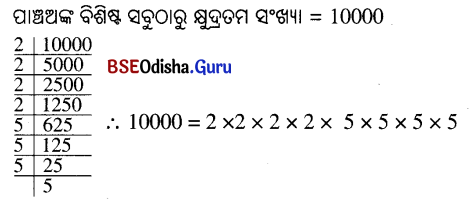
(ଖ) 4 ଅଙ୍କ ବିଶିଷ୍ଟ ସବୁଠାରୁ ବୃହତ୍ତମ ସଂଖ୍ୟା ଲେଖ ଓ ଏହାକୁ ମୌଳିକ ଗୁଣନୀୟକରେ ବିଶ୍ଳେଷଣ କର ।
ସମାଧାନ:

(ଗ) 1729ର ମୌଳିକ ଗୁଣନୀୟକ ନିର୍ଣ୍ଣୟ କର ଓ ସେଗୁଡିକ ଉର୍ଦ୍ଧ୍ବକ୍ରମରେ ସଜାଇ ଲେଖ । ଏଥିରେ ଗୁଣନୀୟକମାନଙ୍କ ମଧ୍ୟରେ ଥିବା ସମ୍ବନ୍ଧ ପ୍ରକାଶ କର ।
ସମାଧାନ:

(ଘ) ମୌଳିକ ଗୁଣନୀୟକ ବିଶ୍ଳେଷଣ ପ୍ରଣାଳୀରେ 24 ଓ 40 ର ଗ.ସା.ଗୁ. କେତେ ହେବ?
ସମାଧାନ:
8 ଅଟେ ।
ଉତ୍ତର ଲେଖ –
(i) ଯେ କୌଣସି ଦୁଇଟି ସଂଖ୍ୟା ନିଅ, ସେ ଦୁଇଟିକୁ ତୁମ ଖାତାରେ ଲେଖ।
ସମାଧାନ:
48 ଓ 64
(ii) ତୁମେ ନେଇଥିବା ସଂଖ୍ୟା ଦୁଇଟିର ଗ.ସା.ଗୁ. ନିର୍ଣ୍ଣୟ କର ।
ସମାଧାନ:
ଗ.ସା.ଗୁ. = 2 × 2 × 2 × 2 = 16
(iii) ତୁମେ ନେଇଥିବା ସଂଖ୍ୟା ଦୁଇଟିର ଲ.ସା.ଗୁ. ନିର୍ଣ୍ଣୟ କର ।
ସମାଧାନ:
ଲ.ସା.ଗୁ. = 2 × 2 × 2 × 2 × 3 × 4 = 192

(iv) ତୁମେ ପାଇଥିବା ଲ.ସା.ଗୁ. ଓ ଗ.ସା.ଗୁ.ର ଗୁଣଫଳ ନିର୍ଣ୍ଣୟ କର ।
ସମାଧାନ:
ଲ.ସା.ଗୁ. × ଗ.ସା.ଗୁ.ର = 192 × 16 = 3072
(v) ଏବେ ତୁମେ ନେଇଥିବା ସଂଖ୍ୟା ଦୁଇଟିର ଗୁଣଫଳ କେତେ ହେଉଛି ସ୍ଥିର କର ।
ସମାଧାନ:
ସଂଖ୍ୟାଦୁଇଟିର ଗୁଣଫଳ = 48 × 64 = 3072
(vi) ସଂଖ୍ୟା ଦୁଇଟିର ଗୁଣଫଳ ସହିତ ଲ.ସା.ଗୁ. ଓ ଗ.ସା.ଗୁ.ର ଗୁଣଫଳର କ’ଣ ସମ୍ପର୍କ ପାଉଛ ?
ସମାଧାନ:
ସଂଖ୍ୟା ଦୁଇଟିର ଗୁଣଫଳ ସହିତ ଲ.ସା.ଗୁ. ଓ ଗ.ସା.ଗୁ.ର ଗୁଣଫଳ ସମାନ
କହିଲ ଦେଖ୍ :
(a) ଦୁଇଟି ସଂଖ୍ୟାର ଗୁଣଫଳ ଓ ସେମାନଙ୍କର ଲ.ସା.ଗୁ. ଦିଆଯାଇଥିଲେ, ସଂଖ୍ୟା ଦୁଇଟିର ଗ.ସା.ଗୁ. ନିର୍ଣ୍ଣୟ କରିପାରିବ କି ? କିପରି ?
ସମାଧାନ:
ଗ.ସା.ଗୁ. = ସଂଖ୍ୟା ଦୁଇଟିର ଗୁଣଫଳ + ଲ.ସା.ଗୁ.
(b) ଦୁଇଟି ପରସ୍ପର ମୌଳିକ ସଂଖ୍ୟାର ଗୁଣଫଳ 21 ହେଲେ ସଂଖ୍ୟା ଦୁଇଟିର ଲ.ସା.ଗୁ. କେତେ ?
ସମାଧାନ:
ଲ.ସା.ଗୁ. = 21
![]()
![]()
![]()
![]()
![]()
![]()
![]()
![]()
